Hall of Fame Original Florida Highwaymen
Fort Pierce, Florida, Legend of the Road!

James Gibson 1938-2017
"The History Maker," "James David Gibson a Legend of the Road," is an icon on the Highwaymen Heritage Trail in Fort Pierce, Florida. James Gibson taught AJ Brown to paint. Gibson's status as an Original Highwayman was the official beginning of Brown's Highwaymen membership. As the only non-blood female, 2nd Generation Highwaymen of the group, AJ Brown, became a part of Gibson's legacy and Highwaymen's history.
During the 1960s, raised with Highwaymen Art, Brown's uncle Alfred was the first introduction during her early childhood years. Several paintings hung on the walls in each room of his small house. Brown's imagination ran wild during summer vacations as she envisioned taking walks through back-wood scenes, swimming in canals, and night fishing along the river banks of Florida's paradise.
James Gibson and Brown's uncle Alfred Kincey lived in the Lincoln Park neighborhood in the early years, as did many Highwaymen. Mr. Gibson lived on Matanzas Avenue for many years, neighbors of Brown's aunt Ruth and uncle Alfred. One breezy fall day in September, Brown's aunt walked her to Mr. Gibson's house on the country dirt road.
A well-respected stucco business owner, Brown's uncle Alfred knew the young men; he collected and supported them early in their careers. During the early days, uncle Alfred paid $25 or less before the men received fame, fortune, or even their name Highwaymen. Decades later, Jim Fitch, an art collector, would name the artists' group, the Highwaymen, for the way they peddled their art along Florida's highways.
The African American men were eager to paint their way out of a life of hunger and poverty. However, they lived in Fort Pierce, Florida's deep south, where systematic laws limited future progress designed for blacks during the Jim Crow Era. The Florida orange groves and tomato fields made life difficult for blacks; the young men began to paint Florida.
Mr. Gibson's small two-bedroom, one-bath home, sat on a long canal that led to the famous St Lucie River; his two large dogs protected the property. He introduced Brown to his life partner of decades, Estelle Dunn, through a collage of pictures of himself and her. Ms. Dunn and Gibson were life partners before his fame, fortune, or success. Over the years, Gibson acquired a list of accolades. The history of James Gibson was owned by the famous; the Bush family also owns a collection of his paintings.
In 2005, James Gibson traveled back in time with history lessons as stories of his life as a Highwayman came to life. Gibson, a legend of the road, was eager to share his talent. The next day, Brown purchased more than $100.00 worth of painting materials, a sparked interest; Mr. Gibson would teach her to paint!
Supplies in hand, Brown returned the next day ready to paint. Mr. Gibson particularly enjoyed sharing his talent with children, but Brown received painting lessons instead of her niece and nephew, the initial reason for wanting to meet with him. His studio was a tiny backyard shed; he lined his boards against the makeshift assembly-style easel. With nails and wood, Gibson used cuts of 2x4s at standing height to paint. The moon shimmered off his backyard canal, brush strokes of Spanish moss hung from tall bushes, and moonlight reflected off palm trees; in the scenes they painted, he asked if she could see the blue in the night? The first two subjects were night scenes, then his famous signature Red Royal Poinciana trees. The production line invention was the idea of Alfred Hair. Hair's makeshift creation became a historical tradition among the group of painters. Brown, the "Second Generation continued tradition."
After nearly two years, James explained his clientele picked up substantially and suggested she continue lessons with Original Highwaymen Johnny Daniels. He advised that Daniels taught Jimmy and Johnny Stovall for over four years when Kelvin Hair joined Daniels's group, with Brown's lessons with James.
A commissioned piece for then-Governor Charlie Crist was one of the last paintings she watched as James completed. It was an honor to work with not one but two entrepreneurs, James and Johnny, for a short while. Johnny's free spirit and mentoring nature were a game-changer to the next level. Side by side, Brown learned by watching Johnny paint. As close as family, they established a kinship; Brown became his God-niece. Johnny asked her to be his business partner in his second "Highwaymen Art Gallery," on Delaware road in Fort Pierce, Florida; She excepted.
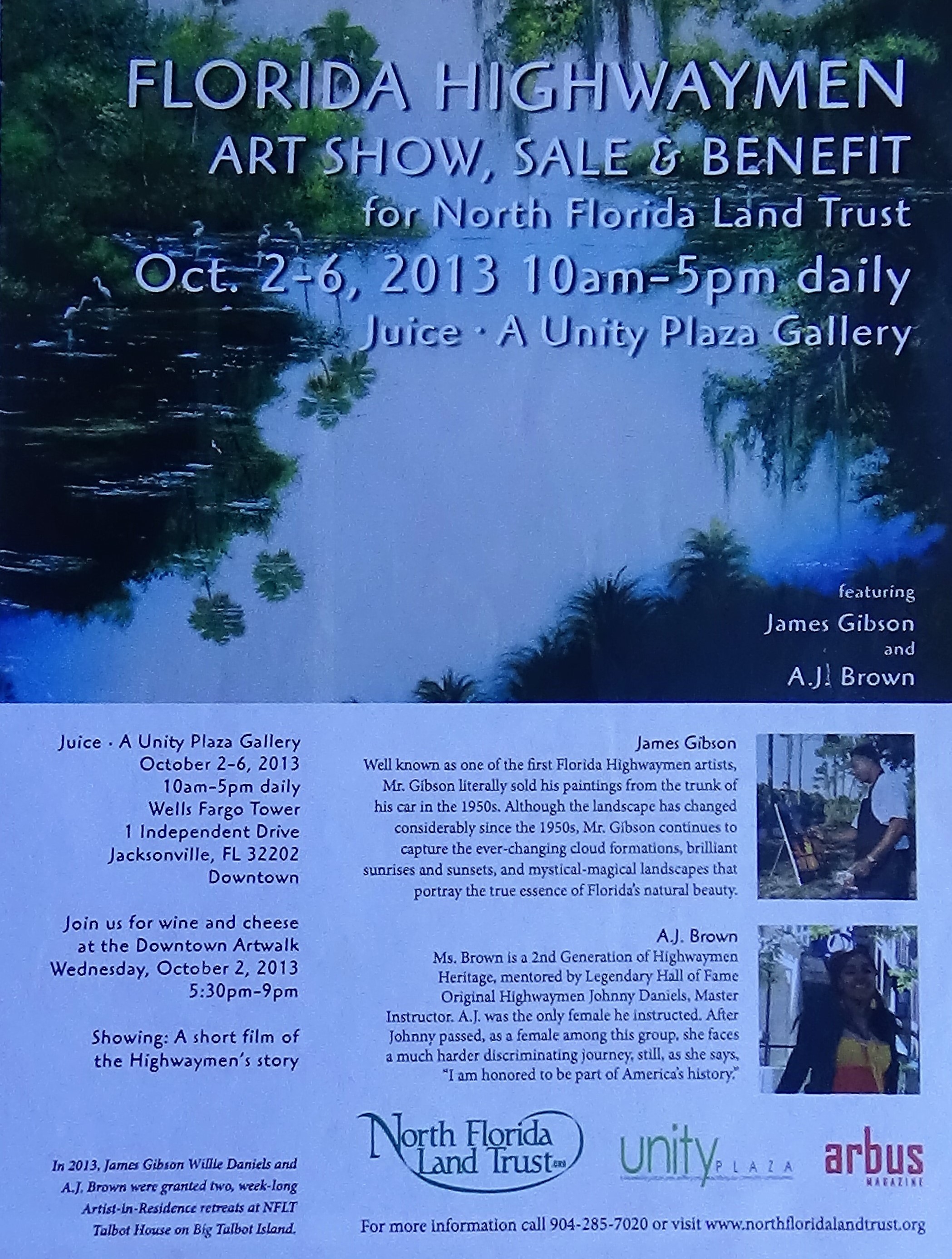
Florida Highwaymen painters James Gibson and AJ Brown Art Show in Jacksonville Florida, Oct 2013
In May 2009, the "Original Highwaymen and 2nd Generation" unified to establish the first historical 501(c)3. Mary Ann Carroll was elected the first president, and AJ Brown was appointed the first Highwaymen Secretary & By-Laws Committee member. Invitations by both James Gibson and Johnny Daniels, AJ attended Highwaymen Art shows throughout the state of Florida. Vero Beach Cultural Center and Port St. Lucie Recreation Center were a mere few. Kathleen Fredrick directed the Annual Highwaymen Art exhibits at the AE Backus Museum in Fort Pierce, Florida. In 2007, the Cultural Affairs Highwaymen Re-dedication was on the list. The Original Highwaymen established a tradition of performing shows throughout Florida with the 2nd Generation Highwaymen. Traveling the back-country roads of Florida, AJ found imitation was the sincerest form of flattery. She discovered many mimic the Highwaymen's Art, traditions, and movement. Our history and body of work inspired and touched folks across America. James Gibson and Johnny Daniels are legendaries of the 1950s and 60s. The young men used oils to document the state of Florida and helped make Highwaymen Art what it is today!
The Good Friend
Part of James Gibson's history was a story of the early years and his close friend, Alonzo Pratt. In the mid-1960s, Al Black became the salesman for the group, but he was not the first. In the beginning, the early original sales associates started in the 1950s, Alonzo Pratt, Minnesota Fats, Zoom, and a few others. They sold to residents, and businesses along the side of the road throughout Florida, long before the young men acquired fame, fortune, or name recognition. The entrepreneurs had no clue that what they started would lead to success! Working miles of fields picking tomatoes, oranges, and grapefruits well into the night made the next-day early rise exhausting.
Oil painting was a rare career for African Americans during the Jim Crow Era. But, against all odds, they earned their way out of poverty and despair. Alonzo made extra money selling art for the men. Alonzo was a well-dressed, attractive young man in his 20s with a winning personality. Alonzo stood approximately 6'3" and had medium brown chocolate skin, smooth tones, admiring features, and a million-dollar smile. His jet black wavy hair with a slight curl made him a strikingly handsome man! Women were helplessly drawn in by his charisma. It was easy to understand why James liked hanging out with Alonzo. James, a young man in his 20's, was also an attractive figure. James and Alonzo earned good money, which attracted females of all colors, and made sex a fair trade.
One day Alonzo saw his good friend, Cowboy, beating his girlfriend. Respectful of the ladies, Alonzo approached his friend, saying it's not cool to strike a female, and asked him to stop. Cowboy's anger overtook him, and Alonzo was asked to mind his business! Alonzo responded, "Hey man, I don't care what she's done; you don't use a lady as a punching bag!" "I'm not going to repeat it. Stay out of grown folks' business," Cowboy responded! He turned away from Alonzo and continued to whale on his lady friend. Being the gentlemen Alonzo was, he couldn't stand by watching his friend use his lady as a punching bag. Alonzo turned Cowboy on his heels and hit him in his mouth. In return, Cowboy landed a punch on Alonzo's jaw. The two men broke out into an all-out brawl.
Alonzo picked Cowboy up entirely off his feet and threw him into a nearby store-front glass window. The shattered glass flew everywhere. The fight was over. Cowboy's girlfriend ran in one direction, and Alonzo took off running in the other. Eventually, Cowboy picked himself off the floor and staggered outside, stepping over the glass, and down the sidewalk toward home. The store owner wanted his window repaired and searched for the person responsible. Fearing the consequences of jail time, no one wanted to stick around to see what would happen when the police arrived. Cowboy held a grudge and didn't see Alonzo for a while.
Alonzo and Cowboy went to Upstate NY on separate field buses with contractors to pick apples. It was the season for picking fruits and vegetables, a prevalent system of earning a living for blacks during the 1960s. All over America, for miles and miles of land, far and wide, blacks migrated from city to city and state to state. Sometimes, from country to country, Bahamians and Jamaicans came to America. They arrived on contacts to join American black field hands, picking crops on properties owned by white Americans. Unfortunately, the back-breaking hard labor earned them little income. The depressing life barely kept food on their tables.
One day after picking crops, Alonzo wanted to relax and unwind. So he thought he'd meet up with the guys at a local hang-out for a few gambling rounds. "Hey man, what's up; can anyone join this game?" "Yeah, man, pull up a chair, take a seat at the round table;" Alonzo was pretty good at gambling. Excited to win money, in those days, a game of cards was high on the list of ways a black man earned extra income. Alonzo pulled up a chair facing the guys. As a few hours rolled by and after winning a few rounds, Cowboy walked through the door and noticed his friend Alonzo, who he had not seen since the brawl, sitting at the round table. Without saying a word, Cowboy turned around and headed outside. He returned after a few minutes and walked back through the front door. Cowboy called out to his friend Alonzo. Alonzo looked back and saw Cowboy standing in the doorway. Cowboy held a 45 caliber Smith and Weston in one hand and aimed at him. Alonzo stood up and, without warning, pulled the trigger and unloaded rounds into his friend's body! Alonzo fell to his knees and then to the floor. Alonzo's last words to his friend were, "Don't kill me, man." Alonzo died near the roundtable!
An unforgettable scene to those who bared witness, Alonzo was dead, so Cowboy turned and ran! The friend took revenge; his rage turned the relaxing afternoon into a horrific, tragic evening that would affect friends, family, and James Gibson for years to come. The Highwaymen had lost their salesman. No one could have guessed, not even Alonzo, that his friend would turn on him with thoughts of murder. But for Cowboy, seeing his friend again brought back fresh memories of the day he lost his girl and his pride, which drove him into a blind rage, he couldn't stomach his tarnished pride. Alonzo protected his best friend's girl, so Alonzo was dead; he lay lifeless on the floor. The family buried Alonzo in Fort Pierce, Florida.
Cowboy did about six years for the murder of Alonzo Pratt. James ended his memory of his friend that day. "The story played over and over in AJ's mind as she drove home for the weekend. She would return on Monday for regular painting sessions and another history lesson of the early years." Some of the many tales told of the Highwaymen have slightly varied, depending on whom she spoke.
As small-town Fort Pierce would have it, Alonzo was the father of AJ's auntie's first-born son in 1961. A young lady at the time, her son was Alonzo's second son and AJ's first cousin. Memories returned fresh from back in the day when AJ and her cousin were raised together as kids in Miami. He'd just received the heartbreaking news; AJ could feel the spirit of her cousin's sadness. It wasn't till later that AJ understood the devastation her cousin must have suffered. He'd grown up without his biological father, a definite loss of true love. He remembered his father, who spent time with him, the love they both shared, and cherished memories of the times they went fishing. Auntie later married; her husband became her siblings' father. They spent the remainder of their lives living in Fort Pierce, Florida. After 30 years of marriage, Uncle died of a brain tumor, and auntie was alone. She learned to adjust to the difficult days ahead.

Florida Highwaymen painter James Gibson is commissioned by Governor Charlie Crist, February 2008
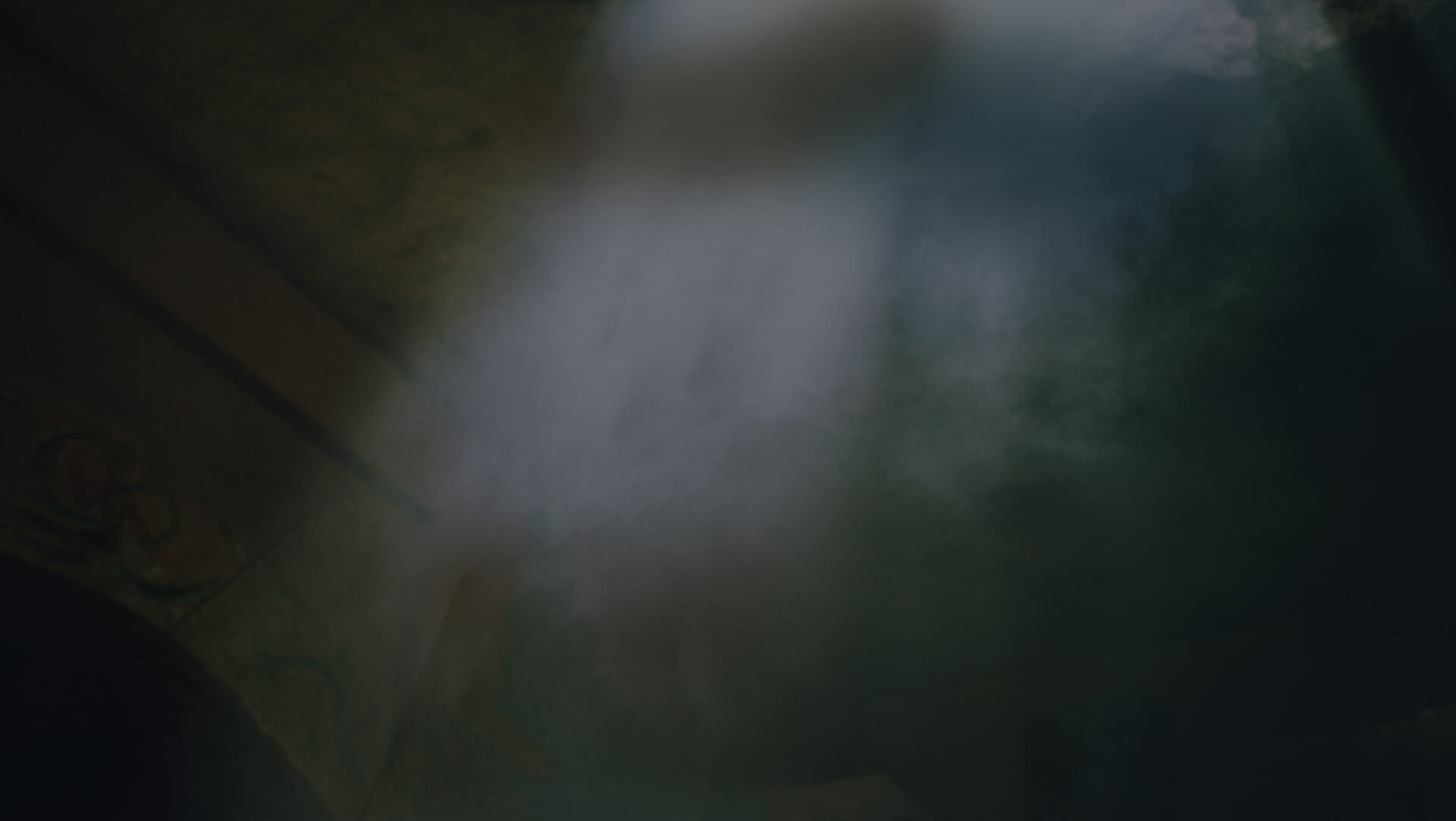

Florida Highwaymen Scholar James Gibson teaches AJ Brown to paint the Highwaymen famous Red Royal Poinciana Trees, on his makeshift assembly line, invented by Alfred Hair, September 2005
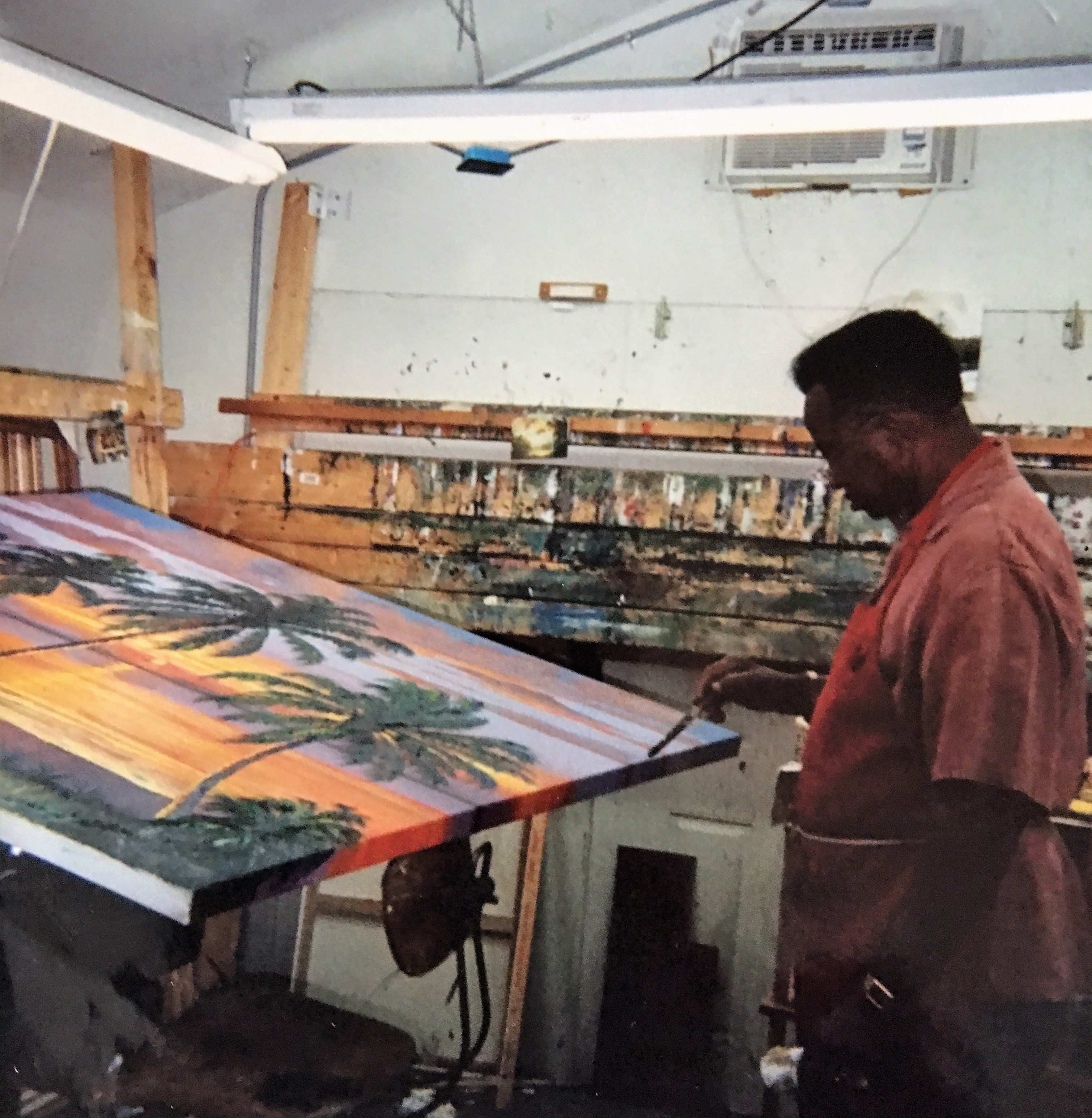
The last painting AJ watched James paint in his makeshift studio, was for the Governor of Florida, Jan 2008

Florida Highwaymen James Gibson was commissioned to paint for Florida's Governor Charlie Crist. Gibson's backyard in Fort Pierce, Florida, photos by AJ Brown, Feb 2008
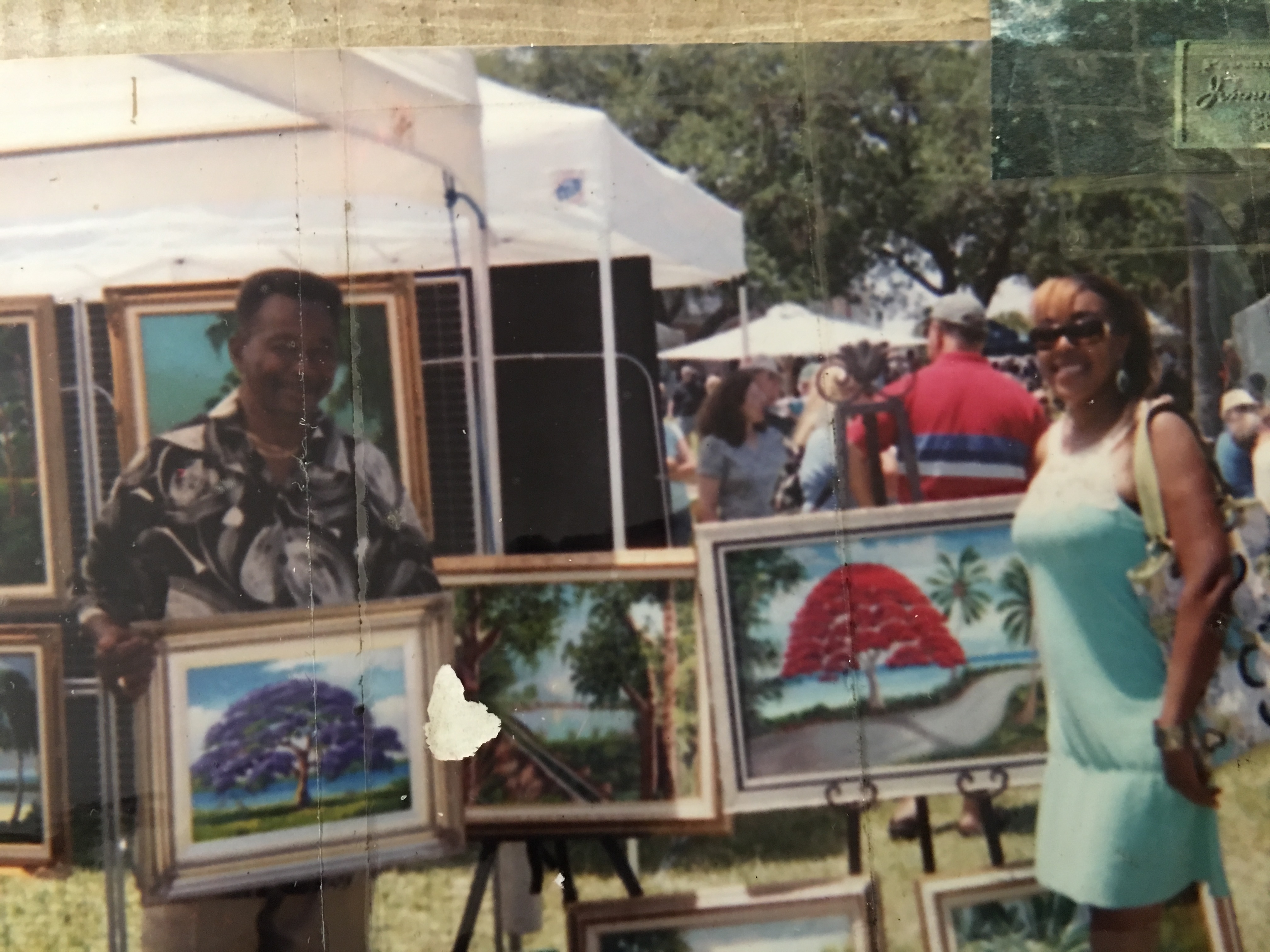
Vero Beach Heritage Center Art Show, Gibson shares his booth with Brown, 2008
